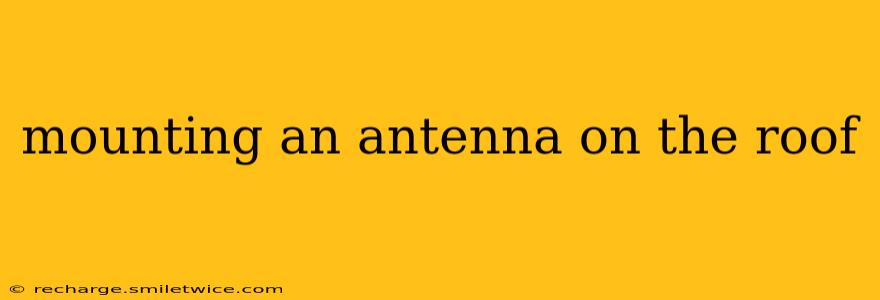Mounting an antenna on your roof can significantly improve your TV reception or expand your wireless internet reach. However, it's crucial to do it safely and correctly to avoid damage to your roof, the antenna, and yourself. This guide will walk you through the entire process, addressing common concerns and providing practical advice.
What Type of Antenna Are You Mounting?
Before you even think about climbing onto your roof, you need to know what kind of antenna you're working with. Different antennas have different mounting requirements. A small, lightweight TV antenna might have simpler mounting needs than a large, heavy directional antenna for ham radio. Understanding the antenna's weight, size, and mounting instructions is paramount.
What Tools and Materials Will I Need?
The tools and materials required will vary depending on your roof type and the antenna itself. However, here's a general list:
- Appropriate antenna mount: This will depend on the type of antenna. Consult your antenna's instructions.
- Drill and appropriate drill bits: You'll likely need bits for pilot holes and for the mounting hardware.
- Screwdrivers: Match the type of screws used in the mount and the antenna itself.
- Ladder: A sturdy ladder that extends well above the roofline is essential. Consider using a ladder stabilizer for added safety.
- Safety harness and rope: This is crucial for safety, especially on steeper roofs.
- Caulk: Use weatherproof caulk to seal around the mount to prevent leaks.
- Measuring tape and level: For accurate placement and alignment.
- Wrench(es): To tighten bolts securely.
- Work gloves: To protect your hands.
- Safety glasses: To protect your eyes from debris.
How High Should I Mount My Antenna?
The optimal height for your antenna depends on several factors, including the terrain, the presence of obstacles, and the type of signal you're trying to receive. Generally, the higher you mount it, the better reception you'll get, but safety should always be the top priority. Check local building codes and regulations for height restrictions.
What are the Safety Precautions I Should Take?
Rooftop antenna installation is inherently risky. Never attempt this alone. Always have a spotter on the ground to assist you. Here's a breakdown of essential safety precautions:
- Inspect the roof: Check for any weak points or damage before you begin.
- Use a sturdy ladder: Ensure your ladder is long enough and placed on stable, level ground.
- Wear appropriate safety gear: This includes safety glasses, work gloves, and a safety harness with a secure anchor point.
- Check the weather: Do not attempt installation during rain, snow, or high winds.
- Be aware of power lines: Always maintain a safe distance from power lines. Contact your local utility company if you are unsure.
- Take breaks: Rooftop work can be tiring. Take regular breaks to avoid fatigue.
How Do I Prevent Water Leaks?
Proper sealing is essential to prevent water damage to your roof. After mounting the antenna, carefully apply a generous bead of weatherproof caulk around the base of the mount to create a waterproof seal.
What is the Best Way to Mount an Antenna on a Tile Roof?
Mounting on a tile roof requires extra care to avoid damaging the tiles. Use specialized mounts designed for tile roofs, and work carefully to avoid cracking or breaking the tiles. Consider using sealant specifically designed for tile roofs.
How Do I Choose the Right Antenna Mount?
The right mount depends on your antenna type, roof material, and the direction you need to point the antenna. Consult your antenna’s instructions for recommended mounts, or seek advice from a professional installer.
What are the Legal Requirements for Mounting an Antenna?
Check your local building codes and homeowner's association regulations before mounting an antenna. There may be restrictions on height, location, and the type of antenna you can install.
Remember, safety is paramount. If you're uncomfortable with any aspect of this process, it’s best to hire a professional antenna installer. The cost of professional installation is often far less than the cost of repairing roof damage or dealing with a serious injury.
